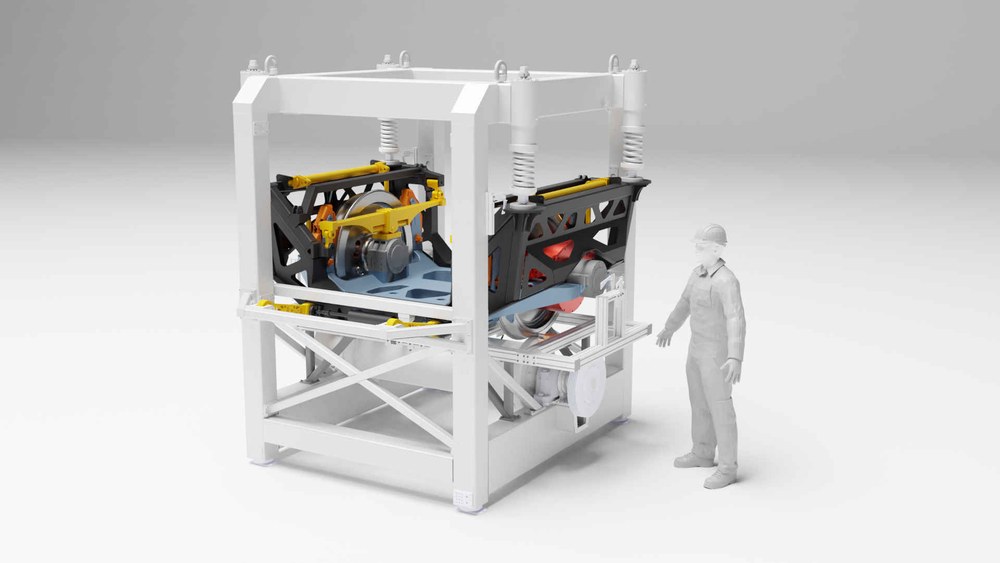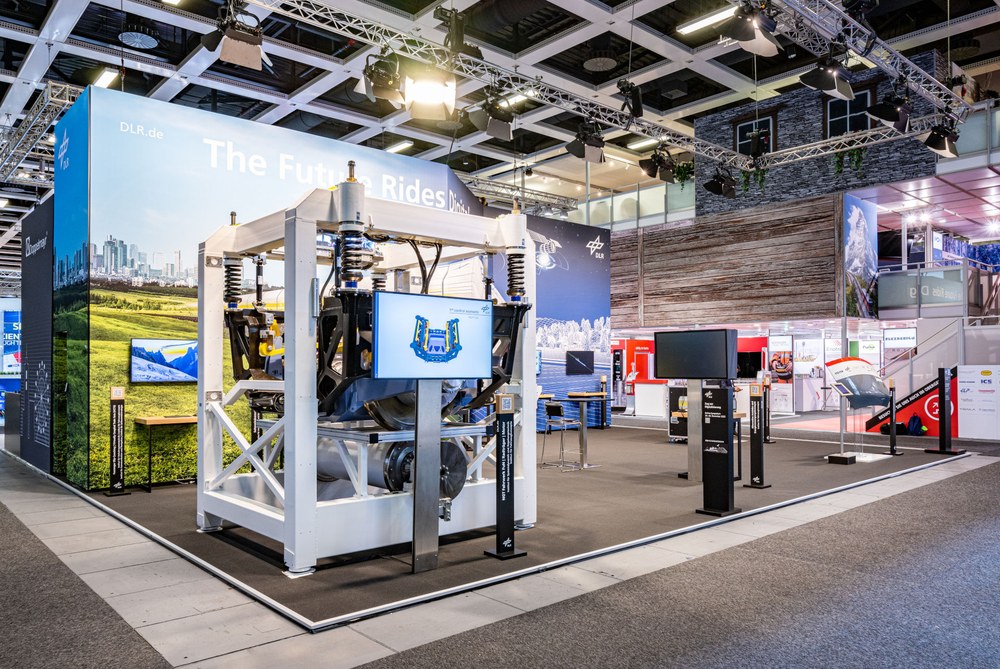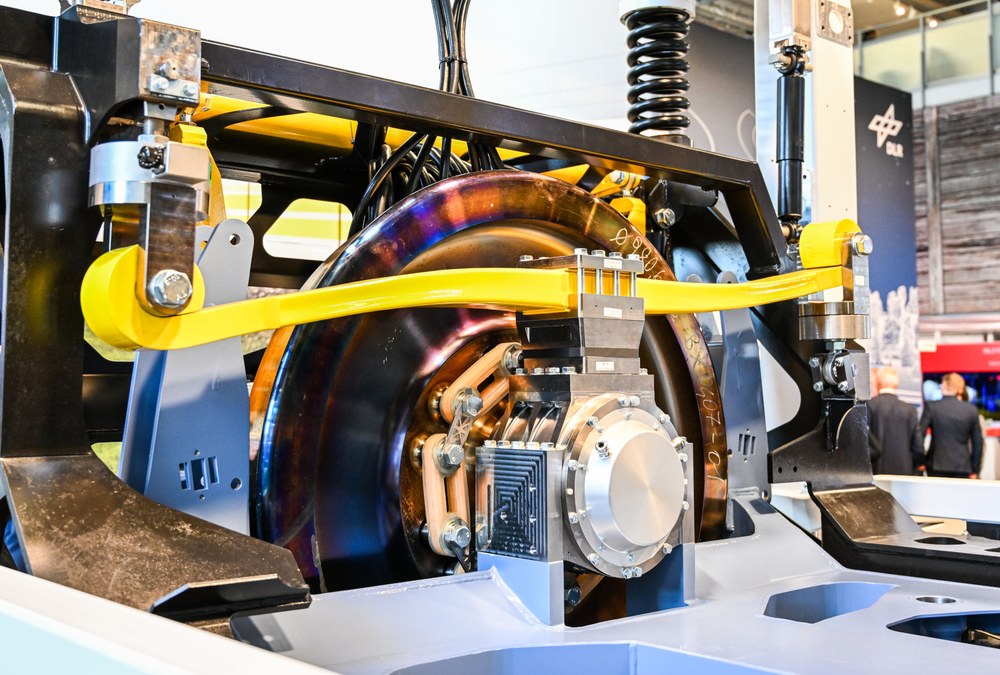A high-tech running gear for the train of the future



- DLR has developed a new running gear design for the train of the future. Each wheel is driven separately and controlled intelligently.
- The advantages include more efficient and quieter driving, less wear and tear on wheels and rails, and new freedom in the construction and design of the car interior.
- DLR is presenting a full-scale functional model of this chassis for the first time at InnoTrans 2022 in Berlin.
- Focus: Transport, future mobility, rail transport
The running gear of a train is a key factor for fast, reliable, safe and comfortable rail transport. The German Aerospace Center (Deutsches Zentrum für Luft- und Raumfahrt; DLR) is working on a new, running gear design for the future as part of its Next Generation Train (NGT) concept, with each wheel driven individually and controlled with smart technology.
According to project leader Andreas Heckmann of the DLR Institute of System Dynamics and Control, this approach offers significant and wide-ranging advantages: "It could make trains quieter and more efficient, with less wear and tear on wheels and rails. The structure and materials used in this high-tech chassis have also been optimised to make the drive motors as light as possible. This is where the DLR Institute of Vehicle Concepts has lent its expertise. Reducing the weight lowers the energy consumption and allows for larger load capacities. It also offers new scope in the construction and design of the car interior."
DLR is developing ground-breaking new bogie technology for train undercars
In the rail sector, bogie frames with two wheelsets are traditionally used for the train undercar beneath the railcar body. The bogie can move relative to the railcar body and align itself along curves in the track. Thanks to the profile of the wheels and their axles, the wheelsets stay where they should because they automatically align themselves with the middle of the track. Even though running gear concepts have been continuously developed and improved over time, this principle has long remained unchanged.
However, bogies are large and heavy, making them a crucial factor when designing a train. The classic bogie poses a challenge, especially with double-decker coaches, as passengers must climb stairs over the running gear on the lower level and there cannot be a consistently level surface. But with a flat car body floor that lies entirely above the wheelsets, a double-decker train would be too high. It could not run on the existing rail infrastructure and would not fit through today’s tunnels. Nevertheless, double-decker cars have the obvious advantage of making the most efficient use of the existing infrastructure and track capacity, as they allow more people and goods to be transported.
Towards a smart chassis
The technology still has a few hurdles to overcome before the advantages of the NGT running gear concept can be leveraged in practice. One of the biggest is the control technology. "If we take DLR's NGT high-speed train as an example, we are considering a train that is 200 metres long and has 10 cars. The two end cars have eight wheels each, while the eight middle cars have four wheels each. This gives us a total of 48 wheels, all of which have to be controlled and adjusted individually," says Heckmann. Each pair of wheels, consisting of a left and a right wheel, has its own control computer within the car body and its own sensor system. In other words, it is 'intelligent'. The position of the pair of wheels in the track channel – how far to the left or right a pair of wheels travel along the rails – needs to be constantly monitored and controlled. "This is both a technological challenge and an exciting new opportunity. For the first time, we can determine exactly where the wheel runs on the rail and thus where it should or may start to wear out," says Heckmann, who also states that the accuracy of these measurements will be between one tenth and half a millimetre. "This could allow pairs of wheels to run for longer in the future, as we have a specific idea of the wear process and can plan maintenance more effectively." The on-board sensors operate continuously and thus also make it possible to obtain data on the condition of the routes, which could be used to monitor and maintain the route network.
The concept has already shown promise in simulations and experiments with a 1:5 scale model of the NGT running gear. DLR researchers are now building a full-scale functional model and test stand. They are keen to get the chassis running for the first time and test the position and function of the sensors and control devices. The technology is set to be further developed and demonstrated over the next few years using the NGT FuN research infrastructure. DLR's high-tech running gear will then be tested on special test stands at external rail service providers, with the aim of completing a practical test on suitable tracks as soon as possible.
InnoTrans 2022: experience DLR rail transport technology live
DLR will present its NGT running gear and NGT FuN research infrastructure to the public for the first time at InnoTrans, which will take place from 20 to 23 September 2022 in Berlin. DLR will be located at Stand 460 in Hall 2.2.
